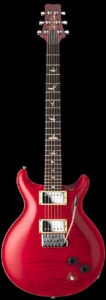With a street price of under $3,000, the third Santana Guitar was probably created, in part, to make a Santana Signature guitar more accessible to working musicians. As such, it incorporates the bulk of the features of the Santana II guitar, without all the pricey woods and other upgrades.
Ultimate Santana Guitar Value?
It’s still got a Maple top on a Mahogany body, but the flamed grain is not as prominent. While the look isn’t quite as striking as the Santana II guitar, the sound is probably fairly similar. In addition, the Abalone Purfling on the top is gone. Again, this probably doesn’t affect the tone, but certainly saves money in materials, and even more so in man-hours.
Another alteration is the headstock, which, while color-matched to the body, does not have a Rosewood overlay.
Classic Santana Guitar Neck
 Like all the Paul Reed Smith Santana Guitars, the neck is the ubiquitous “Santana wide fat,” but the fretboard radius has been returned to the more standard 10″ curvature. (For how this is calculated, imagine a 10″ circle, then take about 2″ of the outline: that’s the top of the fretboard, viewed on end. As you can imagine, the larger the circle, the “flatter” that 2″ segment would be.)
Like all the Paul Reed Smith Santana Guitars, the neck is the ubiquitous “Santana wide fat,” but the fretboard radius has been returned to the more standard 10″ curvature. (For how this is calculated, imagine a 10″ circle, then take about 2″ of the outline: that’s the top of the fretboard, viewed on end. As you can imagine, the larger the circle, the “flatter” that 2″ segment would be.)
The fretboard itself is listed as “East Indian” Rosewood, as opposed to “Brazilian” Rosewood. While maintaining much of the rich tonal response of Brazilian Rosewood, the East Indian Rosewood is more available, and, therefore, less expensive. (Brazilian Rosewood has been endangered for years, and is more costly and difficult to obtain.)
Other Santana Guitar Comparisons
One area in which PRS definitely did not cut back was the color selection; the Santana III is available in most of the same finishes as the Santana II. The tuning pegs are locking, but no longer Schallers, though still quite serviceable. Just like brand names at the grocery store, part of what you are paying for is the name.
Santana III Pickups
Paul Reed Smith has changed the description of the pickups to “Santana III’s”, and no longer describes them as having “Zebra bobbins” (Santana II) or “Zebra coils” (Santana I). They’re also covered, which changes the look, and may actually protect the pickups from dust and other irritants.
PRS Santana III: The Workhorse
In short, Paul Reed Smith’s Santana III guitar has most of the tone and playability of the Santana II, at less than half the cost. Which one is a better fit for you? It depends on your budget, and how plan to use the instrument.
At this point, however, all PRS Santana guitars have been discontinued, except for the Santana MD, the latest release from Carlos Santana and Paul Reed Smith.


